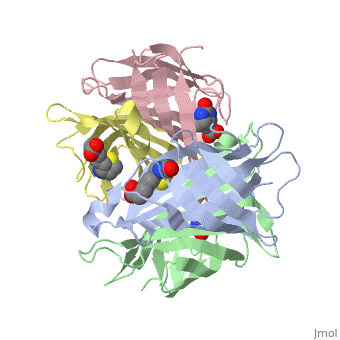Molecular Playground/Streptavidin
From Proteopedia
(Difference between revisions)
| Line 7: | Line 7: | ||
<StructureSection load='1MEP' size='350' side='right' caption='Structure of Streptavidin (PDB entry [[Ŏ1MEP]])' scene=''> | <StructureSection load='1MEP' size='350' side='right' caption='Structure of Streptavidin (PDB entry [[Ŏ1MEP]])' scene=''> | ||
| - | + | ||
In the Schiffman lab, we fabricate many types of soft materials including electrospun nanofibers, hydrogels, and nanoparticles. In order to tailor each material for wound management and health care applications, it is necessary to functionalize each material with polymers, enzymes, growth factors or antibiotics. To attach such molecules, we attach streptavidin to our material and take advantage of the streptavidin/biotin bond to add agents such as biotinylated antibodies. Biotin can attach to any of the four subunits of streptavidin. The <scene name='56/567309/F/1'>disappearance</scene> of biotin in the complex shows where biotin can bind to streptavidin. | In the Schiffman lab, we fabricate many types of soft materials including electrospun nanofibers, hydrogels, and nanoparticles. In order to tailor each material for wound management and health care applications, it is necessary to functionalize each material with polymers, enzymes, growth factors or antibiotics. To attach such molecules, we attach streptavidin to our material and take advantage of the streptavidin/biotin bond to add agents such as biotinylated antibodies. Biotin can attach to any of the four subunits of streptavidin. The <scene name='56/567309/F/1'>disappearance</scene> of biotin in the complex shows where biotin can bind to streptavidin. | ||
</StructureSection> | </StructureSection> | ||
Revision as of 19:13, 5 November 2013
The Use of Streptavidin/Biotin Complex to Functionalize Materials
Streptavidin is a protein best known for its ability to bind to biotin creating the strongest non-covalent interaction in nature.
One of the CBI Molecules being studied in the University of Massachusetts Amherst Chemistry-Biology Interface Program at UMass Amherst and on display at the Molecular Playground.
| |||||||||||

